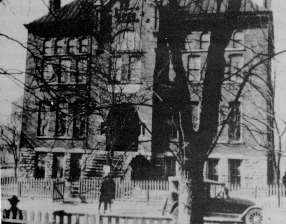 Walden
University began as a school for freedmen under the sponsorship of northern
Methodist Episcopal Church missionaries. In late 1865, the Reverend A.A.
Gee and others began classes for freedmen in Andrew Chapel M. E. Church
(now Clark Memorial M. E. Church), moving in 1866 to the old Confederate
gun factory on College Street (now Third Avenue, South). After the Nashville
public schools opened in September of 1867, the school was chartered as
Central Tennessee College, under the Reverend W. B. Crichlow. The school's
board of trustees attempted to purchase land on Rutledge Hill, but white
residents obtained a court order to block the sale. In 1868, Central Tennessee
College purchased the Nance property on Maple Street (now First Avenue,
South), where the Bureau of Freedmen, Refugees and Abandoned Lands helped
to finance the construction of two brick buildings.
Walden
University began as a school for freedmen under the sponsorship of northern
Methodist Episcopal Church missionaries. In late 1865, the Reverend A.A.
Gee and others began classes for freedmen in Andrew Chapel M. E. Church
(now Clark Memorial M. E. Church), moving in 1866 to the old Confederate
gun factory on College Street (now Third Avenue, South). After the Nashville
public schools opened in September of 1867, the school was chartered as
Central Tennessee College, under the Reverend W. B. Crichlow. The school's
board of trustees attempted to purchase land on Rutledge Hill, but white
residents obtained a court order to block the sale. In 1868, Central Tennessee
College purchased the Nance property on Maple Street (now First Avenue,
South), where the Bureau of Freedmen, Refugees and Abandoned Lands helped
to finance the construction of two brick buildings.
Central Tennessee College operated from 1870 to 1900 under John Braden, a Union army chaplain. By 1874, the school's 240 pupils studied grammar and secondary and normal (classical and teacher training) subjects. During Braden's presidency, the school began to issue college degrees.
In 1876, the Meharry Medical Department was added to Central Tennessee College. The head of the department was Dr. George Whipple Hubbard (1841-1921, a teacher for the Pittsburgh Freedmen's Aid Commission and former principal of Nashville's first Negro public school, Bellview.
During the 1880s, Central Tennessee College grew rapidly and added several new departments: law (1877-l882), industrial art (1885), dentistry (1886), and pharmacy (1889). In the IX90s, the school expanded its female and industrial education opportunities, adding a nursing department in 1892. Young female students also could learn domestic science in such courses as sewing, cooking, and home economics. Around 1895, the students attempted to stage a rebellion while demanding more black faculty members, but they quieted down because of respect for "old man Braden" and his life-long devotion to freedmen's education.
In 1900, the name of the school was changed to Walden University, in honor of Bishop John Morgan Walden, formerly a freedmen's missionary. Then the school had thirteen departments, a faculty of sixty-eight, and 1,360 alumnae. Thereafter, the suitability and success of Walden declined. In 1911, for example, the school graduated only one law student. Walden University found it increasingly difficult to attract grammar and high school students after the Tennessee Agricultural, Industrial, and Normal State School was opened in Nashville in 1912.
Alumnus Edward A. White became the first black president of Walden University in 1915, which was a year of financial hardship resulting from the depression of 1914-1915. Also in 1915, the Meharry faculty decided to form a separate college. Hubbard secured the charter for Meharry Medical College and remained its president until his death. Meharry retained the old campus.
In 1922, Walden University was renamed Walden College and moved to a twelve-acre campus on the eastern hills overlooking the black neighborhood of Trimble Bottom. The new campus was formerly the site of Stevens Infirmary in 1864. The site was used intermittently by St. Mary's Orphanage from 1863 to 1903. It was a sanitarium from 1905 to 1920 and the home of Judge Chester K. Hart. Walden College operated there until 1925 as a junior college for teacher education, business, the arts, and pre-dental and premedical education. Financial difficulties forced the school to close. Walden College's campus was vacant until 1935, at which time Trevecca Nazarene College leased it, then purchased the campus in 1937.